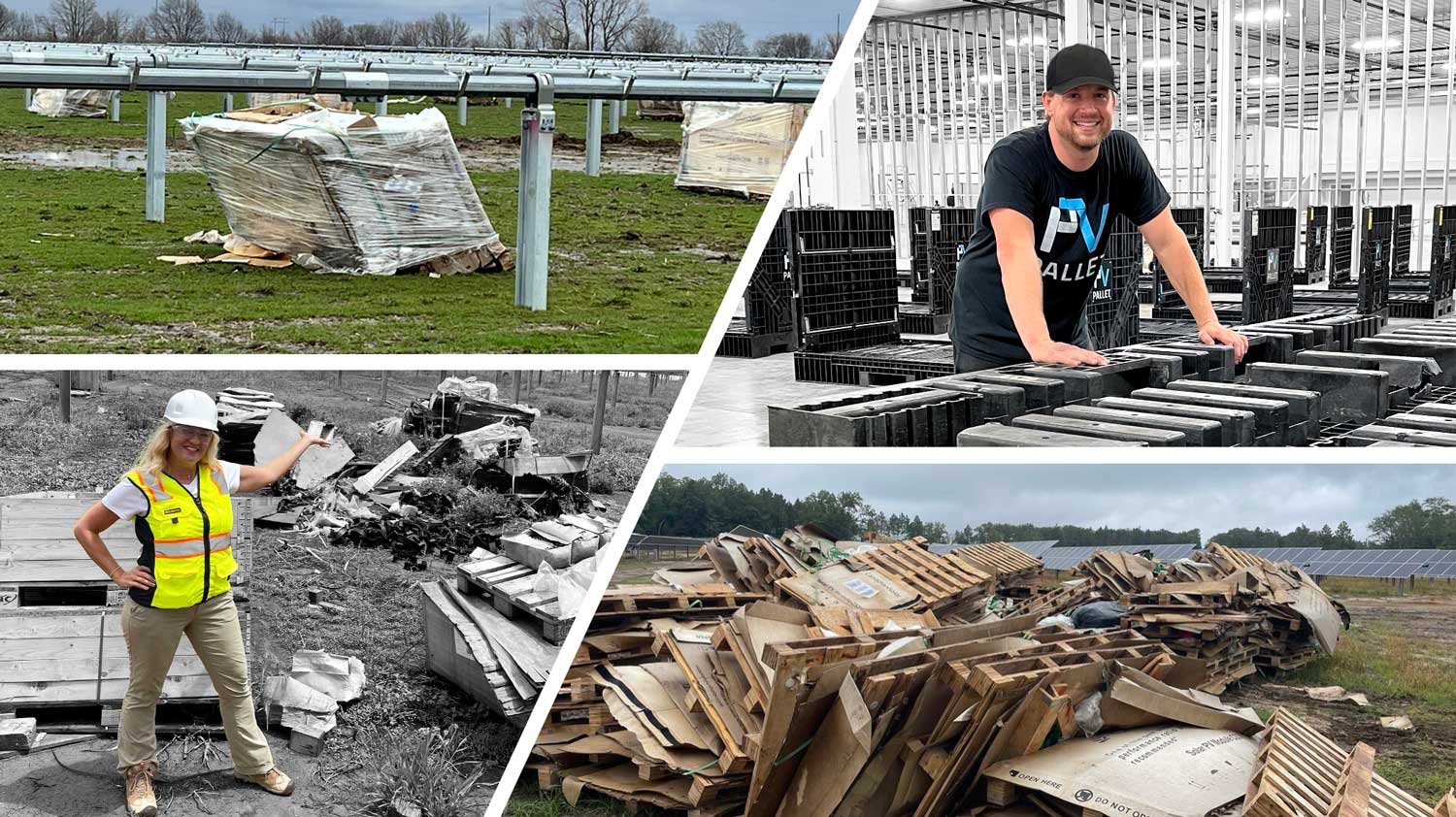Solar Sustainability Trailblazers Emilie Oxel O’Leary and Philip Schwarz Talk Trash (and What to Do With It)
“Here we were, building these great projects powered by the sun, but turning around and filling the Earth with all this waste,” says Green Clean Solar CEO Emilie Oxel O’Leary, who saw firsthand the broken solar panels, cardboard, wood pallets, plastic, metal, and everything else that typically winds up in a landfill at the end of a solar installation. “It really bothered me.”
That realization motivated Emilie to start Green Clean Solar—a solar waste removal company focused on tackling the solar industry’s trash problem by providing a one-stop solution for utility-scale installation sites to bypass the landfill.
Philip Schwarz, CEO and Co-founder of PVpallet, had a similar epiphany when working on utility-scale solar projects. He wondered why an industry built on sustainability was creating so much waste. This question, combined with his passion for outdoor backpacking and a desire to leave a better planet for his kids, led Philip down the path of preventing waste.
Preventing waste through reusable packaging and ensuring the waste at solar installations bypasses the landfill are both necessary approaches to tackling the 1.1 billion pounds of wood waste and millions of broken solar panels created each year by the solar industry.
Both approaches are necessary. Each year, wood pallets used to ship solar panels become 1.1 billion pounds of wood waste, and an industry-wide 5% of panels shipped on those pallets—21,000,000—are broken prior to installation. Far from being “the cost of doing business,” much of that waste is preventable. Those numbers are shocking, but they’re not the whole story. Today, only 10% of solar panels are recycled, which means a whopping 90% wind up in landfills. And by 2050, 78 million metric tons of solar panels will come to end-of-life.
“Those numbers reflect the clip of growth our industry is experiencing today,” explained Philip. “But we all know our industry is rapidly growing. Solar waste numbers scale linearly right alongside industry growth.”
Figuring out how to responsibly dispose of end-of-life solar panels is essential. A solution is desperately needed, especially when large-scale sites experience hailstorms, fires, and other disasters that render an entire site fast-tracked to decommission/retrofit status. Advancing solar technology will further add to the end-of-life numbers as sites are updated with higher efficiency solar panels.
But there’s good news. We can write all that waste out of the solar industry’s story if we’re willing to change the way we think about waste. To get some tips on how that can be done, PVpallet sat down with Emilie and Philip to discuss actionable ways we can create impactful change. Here are some key takeaways from our conversation.
Q: When it comes to circularity and best practices for solar installations, what are some things people in the industry might not know?
Emilie: The recycling world has core materials that can be recycled, and they can’t all go in one large container. Within the core materials that can be recycled, there are still things that impact how much it costs to recycle something—and whether it can be recycled at all. Here’s an example of what I’m talking about. A lot of companies are using green-colored plastic wrap. We took an entire container of it to a recycler, who told us the green color is much more difficult to process. Because of that, what would have cost $900 to recycle was going to cost over $1000—just because it was green. That’s actually why the Coca-Cola company recently started packaging Sprite in clear plastic bottles instead of green ones.
Philip: We’ve found that there are companies out there that will take back wood pallets for recycling and refurbishment, but there are a few challenges—if not total non-starters—for pallets used in the solar industry. First, these pallets are not a standard size. Second, they’re made from particle board that rapidly degrades. That ultimately means these recycling and refurbishment centers don’t want the solar industry’s wood pallets. I can think of one pallet recycling/refurbishment company in Georgia that got a call about 30,000 pallets at a job site. The company had no interest in taking them because there was nothing they could do with them.
Q: What makes up the waste at a solar installation jobsite?
Philip: At PVpallet, we talk a lot about wooden pallets. But waste at a solar site is more than just pallets. It’s cardboard, corner protectors, plastic wrap, foam dunnage, and more. And the trash doesn’t just come from solar panels and their packaging. Solar installations include other equipment like inverters, racking components, batteries, wiring, etc.—all of which have packaging. It really adds up—both in quantity of waste and disposal costs.
Emilie: Exactly. And the manufacturers that support our industry really haven’t thought about the packaging because their goal is to sell product and get it out to the site. But that means an abundance of core pieces of waste on all job sites: broken panels, the carboard and plastic wrap Philip just mentioned, and metal and plastic straps.
Q: On average, how much is the solar industry spending on trash?
Emilie: Trash isn’t free! Think of it this way: 64 wooden pallets fit into a container, and that container costs $700 to $900 to haul away. That means trashing pallets from a 1 MW install—about 83 pallets—would cost $1,400-$1,800. For larger 100-300 MW installations, companies are paying tens of thousands of dollars to throw away trash.
Philip: Right, and that number is just for wood pallets. It doesn’t even account for the cost to dispose the rest of the trash we’ve talked about—broken modules, cardboard, and other packaging trash. Many EPCs tell us that their trash budget is six figures.
Q: What are the 5Rs of recycling and how can we use them to change the way the solar industry thinks about packaging waste?
Philip: We all grew up hearing Recycle, Reduce, Reuse. It’s baked into our brains and I think we all know it’s smart to do. But now we have the Five Rs: Refuse, Reduce, Repair, Reuse, and Recycle. To me, Refuse is a reminder: we all have a choice. We can refuse to work with companies that add to the waste problem. Likewise, we can make it a priority to work with companies that have circularity built into their product offerings. That includes packaging, end-of-life, all of it. We have a choice, and we can help drive change in the industry by making better choices. When we talk about Repair (which can also be called Repurpose), we need to recognize that most things aren’t single use. We can fix things. We can reuse them. As an industry, we simply need to take more initiative in Refusing and finding creative ways to Repair/Repurpose and Reuse. At PVpallet, we focus on Refuse, Reduce, Reuse, and Repair through reusable packaging.
Emilie: And we focus on Recycle and Repair. For both modules and pallets, we recycle and send things off for repair. I have followed trucks that are filled with our material because I want to see what they’re really doing with it. Then I partner with companies I know are reusing and repurposing those materials on the back end.
Q: How do we create a more sustainable future?
Emilie: A big part of that is in educating and talking with packaging companies. We want to encourage them to redesign their materials with reuse and repurposing built into the process. We need to have the same kinds of conversations with solar manufacturers. Think about all that green plastic I mentioned. If more packaging companies would step in and say, “Hey, we’re only going to use clear plastic,” like the Coca-Cola company did, the recycling process will be easier and cheaper for everyone involved. Those seemingly small decisions—clear plastic instead of green—can make an enormous difference in circularity practices for the solar industry. And these conversations have to happen at the top of these organizations, with manufacturers who are at leaders in their industry and wield a lot of influence.
Philip: Education is definitely key. For example, many people assume that “going green” costs more—but that’s only the case if you’re not looking at it holistically. Much like a reusable versus disposable water bottle, the initial cost is higher with reusable packaging, but there’s a tipping point at which you break even—and then it’s straight savings from that point on. We work with customers to uncover that tipping point. We’ve developed a robust ROI calculator to help our customers quantify how much (and when) reusable packaging could save them. We found that one customer was actually able to break even after one use. We also completed comprehensive life cycle assessment (LCA) comparing a reusable pallet system to a wood pallet so we can really quantify the carbon footprint and environmental improvements of switching to reusable packaging.
I’ll add that so much cost-savings come into the picture in cost-prevention. Emilie and her team do a great job with the waste that can’t be prevented. Finding that good middle ground where we’re preventing as much as possible and then recycling and repurposing/repairing the rest will put the industry in a much better position than we’re in right now. Like Emilie said, to make significant change we have to start collectively working together with everyone involved. Get in a room with your project manager, EPC, and other stakeholders and start working toward a creative solution to meet sustainability goals. The more we educate, the more people in the solar industry are starting to ask questions and beginning to understand that big-picture view of what packaging and end-of-life plans are costing their company. It’s really an exciting time to be in solar and see it transition towards a more sustainable future.






